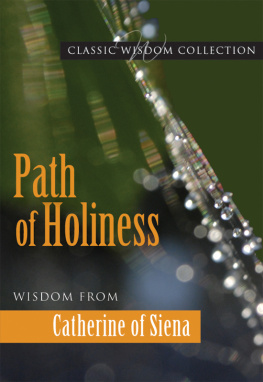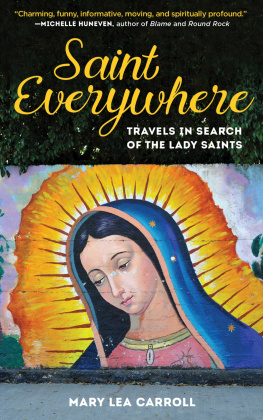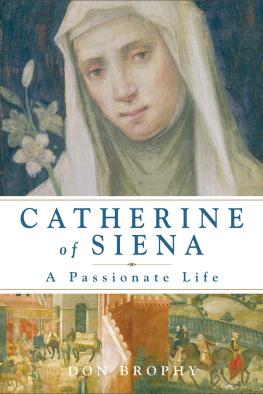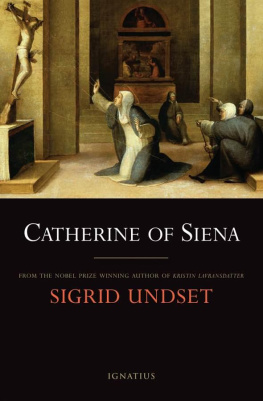Setting the World on Fire
The Brief, Astonishing Life of St. Catherine of Siena
Shelley Emling

St. Martins Press
New York
Thank you for buying this St. Martins Press ebook.
To receive special offers, bonus content, and info on new releases and other great reads, sign up for our newsletters.

Or visit us online at us.macmillan.com/newslettersignup
For email updates on the author, click here.
The author and publisher have provided this e-book to you for your personal use only. You may not make this e-book publicly available in any way. Copyright infringement is against the law. If you believe the copy of this e-book you are reading infringes on the authors copyright, please notify the publisher at: us.macmillanusa.com/piracy .
To Ben and Olivia, both smart, sweet, savvy and two of the four great loves of my life.
This book is also dedicated to girls and women everywhere who, like Catherine of Siena, are breaking the highest and hardest glass ceilings.
Chronology
1226Saint Francis of Assisi, the other patron saint of Italy, dies.
1309The pope moves from Rome to Avignon, France.
1337The Hundred Years War between France and England begins.
1347Catherine is born in Siena on March 25.
1348The plague decimates Siena and much of Europe.
135354Catherine sees her first vision of Christ.
1364Catherine becomes a member of the Mantellate.
136667Catherine has mystical marriage with Jesus.
1370Catherine experiences a mystical death.
1375Catherine receives the stigmata in Pisa.
137778The pope returns to Rome.
1378Catherine goes to Florence on a peacekeeping mission.
1380Catherine dies in Rome on April 29.
1461Catherine is canonized.
1939Catherine becomes patron saint of Italy, along with Francis of Assisi.
1970Catherine is declared a Doctor of the Church.
It is not the hour to seek ones self for ones self, nor to flee pains in order to possess consolations; nay, it is the hour to lose ones self.
Catherine of Siena
For the Italians, food has always been one of lifes greatest pleasures. Whether its pork or lamb, olives or grapes, the sun-soaked peninsula has it, and its good. Yet when Italy, one of the worlds great centers of gastronomy, settled on a patron saint, it chose someone who did everything she could to avoid eating. And it ended up killing her.
That saint was Catherine Benincasa, the frolicsome, imaginative twenty-fourth child of a kind and somewhat prosperous wool dyer. Catherine was born in Siena, a town of economic and political prominence very near Florence, on March 25, 1347, the Feast of the Annunciationa day when people celebrate the angel Gabriels appearance to the Virgin Mary by devouring angel food cake and other baked goods. Perched atop three hills and one of the best-preserved medieval cities in Italy, Siena today looks much as it did in the Middle Ages. The towns sloping, shell-shaped Piazza del Campostill one of the most spectacular open urban spaces in Europewas newly paved with brick and stone the year before Catherines birth. Even as a little girl, Catherine had such a strong sense of self that, at the tender age of seven, she promised her virginity to Christ. Later she had another vision in which Jesus declared his intention to make her his bride. The ring? Christs foreskin, traditionally removed at circumcision. As a teenager, Catherine chopped off her hair in a sign of defiance against being overly groomed by her mother to attract a husband. In her 20s, she received the stigmata, or the spontaneous display on her body of the same wounds Christ received when crucified. As a young woman, her public influence soared because of her reputation for holiness and wisdom. The unschooled mystic commanded popes and kingsas well as ordinary peopleto do the will of God. With the artfulness of Botticelli, this daughter of a merchant mixed mysticism and practical ministry, and was never once intimidated by powerful men.
Although she was illiterate, her major theological treatise on the whole of mankinds spiritual life, The Dialogue, as well as 385 letters and 26 prayersall dictated to secretariesare considered among the most brilliant works of early church literature. They are filled with emotive rhetoric about being washed in the blood of Jesus; in fact, its possible that no one in church history has been as enamored with blood as Catherine. In 2010, Pope Benedict XVI described these writings as a masterpiece that still speaks to Christians today. In 2008, a comprehensive English translation of the saints letters was published as a four-volume series thanks to the work of Sister Suzanne Noffke, an internationally renowned Catherinian scholar. In addition to Catherines own writings, a detailed biography by Raymond of Capua, Catherines most important spiritual adviser and very dear friend, is a vital source for what we know about Catherine today.
While Catherine may have grown up in an average medieval family, with parents and siblings who not only provided for her but who also downright doted on her, the adult Catherine spurned their earthly needs for food and drink with a passion that bordered on the psychotic. In the Middle Ages, control over ones body was seen as a way of achieving oneness with God. As a result, many revered religious women in the history of the Catholic Church cultivated a love-hate relationship with eating. Another Catherine from Italy, St. Catherine of Genoa, followed in Catherine of Sienas footsteps, as did many others, about a century later. This Catherine also ate very little and wouldnt take in so much as a bite during Lent and the 40 days preceding Christmas. But Catherine of Siena took patterns of self-starvation to legendary extremes. She shoved sticks down her throat to make herself vomit. She sipped the pus of the sick and longed to quench her thirst with blood.
Catherines aversion to food started early. Galvanized by her faith, she attempted her first fast when she was only six or seven years old, just after Jesus came to her in a vision, the first of many that would power her extraordinary life. By the time she reached 12 or 13the point at which most girls of that era were married offCatherine refused to eat meat and hot food or to drink wine and subsisted for the most part on morsels of bread and herbs, sips of cold water, and the Eucharist, which she lusted after constantly. The paltry diet caused her to stop menstruating shortly after going through pubertywhen she was barely into her teens. Sleep, too, proved elusive; she rarely napped more than an hour or two a night. Early on, she also made a habit of flogging herself three times a day: once for her own sins, once for the sins of others still alive, and once for the sins of those who had died. After years of such deprivations, this woman with such an appetite for self- mortification reached a point where she could no longer digest even a single bite of food without suffering serious pain. Curiously, she had absolutely no problem whatsoever encouraging others to partake of that which she disdained, distributing copious amounts of food and wine to those in need. Just as Jesus was said to have fed 5,000 people with only five loaves of bread and two fishthe only miracle thats recorded in all four Gospels Catherine managed to miraculously multiply bread and wine to satisfy the hungry during times of scarcity, as was corroborated by several of her contemporaries.
She actually seemed to derive energy not from taking food in but from the act of giving it away.











